Classify anime characters with a fine-tuned model¶
(This notebook is based on mitmul/chainer-handson/animeface-character/classify_characters.ipynb in Japanese.)
In this notebook, we will learn to:
- Fine-tune an Illustration2Vec model on the “animeface-character” dataset.
- Classify 146 kinds of character faces with more than 90% accuracy using the fine-tuned models.
After reading the notebook, using Chainer you should be able to:
- Make a new dataset object.
- Divide a dataset into training / validation.
- Fine-tune a model on a new task by using a trained models.
- Bonus: How to write a dataset class from scratch.
Summary¶
We show a specific example of how to setup a dataset which is not already provided by Chainer and use it for training a network. The basic procedure is almost the same as the chapter that explains the CIFAR 10 dataset class (described in Chainer v 4: Beginner Tutorial, Japanese only for now).
Here, we will explain how to initialize models with weights of pre-trained models. The new model will be initialized with models whose domain is related to our current task. To fine-tune a network from Caffe’s .caffemodel, the procedure is the same.
First, we execute the following cell and install “Chainer” and its GPU back end “CuPy”. If the “runtime type” of Colaboratory is GPU, you can run Chainer with GPU as a backend.
[1]:
!curl https://colab.chainer.org/install | sh -
Reading package lists... Done
Building dependency tree
Reading state information... Done
libcusparse8.0 is already the newest version (8.0.61-1).
libnvrtc8.0 is already the newest version (8.0.61-1).
libnvtoolsext1 is already the newest version (8.0.61-1).
0 upgraded, 0 newly installed, 0 to remove and 0 not upgraded.
Let’s import the necessary modules, then check the version of Chainer, NumPy, CuPy, Cuda and other execution environments.
[2]:
import chainer
chainer.print_runtime_info()
Chainer: 4.4.0
NumPy: 1.14.5
CuPy:
CuPy Version : 4.4.0
CUDA Root : None
CUDA Build Version : 8000
CUDA Driver Version : 9000
CUDA Runtime Version : 8000
cuDNN Build Version : 7102
cuDNN Version : 7102
NCCL Build Version : 2213
Use pip to install the required libraries.
[3]:
%%bash
pip install Pillow
pip install dill
Requirement already satisfied: Pillow in /usr/local/lib/python3.6/dist-packages (4.0.0)
Requirement already satisfied: olefile in /usr/local/lib/python3.6/dist-packages (from Pillow) (0.45.1)
Collecting dill
Downloading https://files.pythonhosted.org/packages/6f/78/8b96476f4ae426db71c6e86a8e6a81407f015b34547e442291cd397b18f3/dill-0.2.8.2.tar.gz (150kB)
Building wheels for collected packages: dill
Running setup.py bdist_wheel for dill: started
Running setup.py bdist_wheel for dill: finished with status 'done'
Stored in directory: /root/.cache/pip/wheels/e2/5d/17/f87cb7751896ac629b435a8696f83ee75b11029f5d6f6bda72
Successfully built dill
Installing collected packages: dill
Successfully installed dill-0.2.8.2
1. Download the dataset¶
First, we will download the dataset, we will use this dataset. Credits to @nagadomi (a Kaggle Grand Master), who created the face area thumbnails from animated character.
[4]:
%%bash
if [ ! -d animeface-character-dataset ]; then
curl -L -O http://www.nurs.or.jp/~nagadomi/animeface-character-dataset/data/animeface-character-dataset.zip
unzip -q animeface-character-dataset.zip
rm -rf animeface-character-dataset.zip
fi
% Total % Received % Xferd Average Speed Time Time Time Current
Dload Upload Total Spent Left Speed
100 564M 100 564M 0 0 56.4M 0 0:00:10 0:00:10 --:--:-- 56.4M
2. Problem settings¶
We use images of anime character faces in “animeface-character-dataset”, and train a network to classify which character is in the image. We classify the character faces in the validation dataset, because we separate training and the validation dataset.
Also, we initialize the model weights using a pre-trained model from a similar domain, rather than randomly initializing the weights. We don’t train our model from scratch, this is commonly known as fine-tuning.
The dataset used for training contains many images, with each characters in its own folder. ### Example images
- 000_hatsune_miku
- 002_suzumiya_haruhi
- 007_nagato_yuki
- 012_asahina_mikuru
3. Creating a dataset object¶
Here, we show how to create a dataset object using a class called LabeledImageDataset which is often used for image classification problems.
First, we will get the path list of the image files. The image files are located in the different directories for each character under animeface-character-dataset/thumb directory. In the code below, if the file ignore is contained in the directory, we will skip that directory to load.
[ ]:
import os
import glob
from itertools import chain
# image directories
IMG_DIR = 'animeface-character-dataset/thumb'
# directories for each character
dnames = glob.glob('{}/*'.format(IMG_DIR))
# the list of image files' path
fnames = [glob.glob('{}/*.png'.format(d)) for d in dnames
if not os.path.exists('{}/ignore'.format(d))]
fnames = list(chain.from_iterable(fnames))
Next, because the name of image directories contains the name of the character, we use it to make an ID that makes it unique for each character.
[ ]:
# Create unique id for each character from the directory name
labels = [os.path.basename(os.path.dirname(fn)) for fn in fnames]
dnames = [os.path.basename(d) for d in dnames
if not os.path.exists('{}/ignore'.format(d))]
labels = [dnames.index(l) for l in labels]
Let’s create a simple dataset object. We simply pass the list of tuples with the file path and its label to LabeledImageDataset. This is an iterator that returns a tuple like (img, label).
[ ]:
from chainer.datasets import LabeledImageDataset
# Crate dataset
d = LabeledImageDataset(list(zip(fnames, labels)))
Next, we use a convenient function called TransformDataset provided by Chainer. This is a wrapper class that takes dataset objects and functions that represent the transformation to each data, which you can use to prepare the data augmentation and preprocessing parts outside the dataset class.
[ ]:
from chainer.datasets import TransformDataset
from PIL import Image
width, height = 160, 160
# function for resizing images
def resize(img):
img = Image.fromarray(img.transpose(1, 2, 0))
img = img.resize((width, height), Image.BICUBIC)
return np.asarray(img).transpose(2, 0, 1)
# transformation for each data
def transform(inputs):
img, label = inputs
img = img[:3, ...]
img = resize(img.astype(np.uint8))
img = img - mean[:, None, None]
img = img.astype(np.float32)
# Flip horizontally at random
if np.random.rand() > 0.5:
img = img[..., ::-1]
return img, label
# dataset with transformation
td = TransformDataset(d, transform)
By doing this, you can create a dataset object that returns the dataset transformed by transform function.
Let’s split this into two separeted datasets for training and velidation. We use 80% of the entire dataset for traiing, and the remaining 20% for validation. split_dataset_random shuffles the data in the dataset once, and then split it.
[ ]:
from chainer import datasets
train, valid = datasets.split_dataset_random(td, int(len(d) * 0.8), seed=0)
Several other functions are also provided, such as get_cross_validation_datasets_random which returns several different pairs of training and verification data sets for cross validation. Have a look at this.:SubDataset
Then, mean used in transform is the average image contained in the training dataset. Let’s calculate this.
[ ]:
import matplotlib.pyplot as plt
import numpy as np
# if the average image is not calculated, just calculate it
if not os.path.exists('image_mean.npy'):
# We want to calculate the average without transformation
t, _ = datasets.split_dataset_random(d, int(len(d) * 0.8), seed=0)
mean = np.zeros((3, height, width))
for img, _ in t:
img = resize(img[:3].astype(np.uint8))
mean += img
mean = mean / float(len(d))
np.save('image_mean', mean)
else:
mean = np.load('image_mean.npy')
Let’s display the calculated average image.
[11]:
# diplay averaged image
%matplotlib inline
plt.imshow(mean.transpose(1, 2, 0) / 255)
plt.show()

You may be scared with the image…
When subtracting the mean from each image, we use the average for each pixel. So, we calculate the average pixel value (RGB) of this average image.
[ ]:
mean = mean.mean(axis=(1, 2))
4. Model definition and preparation for Fine-tuning¶
Next, we will define the model. Here, we define the new model based on the network used in Illustration2Vec, whch can predict tag, extract features and etc. The new model use the layers of Illustration2Vec except last two layers, and add two fully-connected layers instead of them. The two fully-connected layers are initialized randomly.
When traiing, we fix the weights of the Illustration2Vec layers. It means that we only train two newly added layers.
First, I download the trained parameters of the Illustration2Vec model.
[13]:
%%bash
if [ ! -f illust2vec_ver200.caffemodel ]; then
curl -L -O https://github.com/rezoo/illustration2vec/releases/download/v2.0.0/illust2vec_ver200.caffemodel
fi
% Total % Received % Xferd Average Speed Time Time Time Current
Dload Upload Total Spent Left Speed
100 618 0 618 0 0 618 0 --:--:-- --:--:-- --:--:-- 2771
100 933M 100 933M 0 0 35.8M 0 0:00:26 0:00:26 --:--:-- 86.4M
This trained weights are provided in the form of caffemodel, and Chainer is very easy to load Caffe’s trained model (`CaffeFunction <http://docs.chainer.org/en/stable/reference/generated/chainer.links.caffe.CaffeFunction.html#chainer.links.caffe.CaffeFunction>`__). So, we use this to load the parameters and model structure. However, since it takes time to load, we save the Chain object using Python standard module pickle. By doing this, loading model becomes faster next time .
The actual network code is as follows.
[14]:
import dill
import chainer
import chainer.links as L
import chainer.functions as F
from chainer import Chain
from chainer.links.caffe import CaffeFunction
from chainer import serializers
class Illust2Vec(Chain):
CAFFEMODEL_FN = 'illust2vec_ver200.caffemodel'
def __init__(self, n_classes, unchain=True):
w = chainer.initializers.HeNormal()
model = CaffeFunction(self.CAFFEMODEL_FN) # Load and save CaffeModel. (It takes time)
del model.encode1 # Delete unnecessary layers for memory saving.。
del model.encode2
del model.forwards['encode1']
del model.forwards['encode2']
model.layers = model.layers[:-2]
super(Illust2Vec, self).__init__()
with self.init_scope():
self.trunk = model # Include the original Illust2Vec model as trunk in this model.
self.fc7 = L.Linear(None, 4096, initialW=w)
self.bn7 = L.BatchNormalization(4096)
self.fc8 = L.Linear(4096, n_classes, initialW=w)
def __call__(self, x):
h = self.trunk({'data': x}, ['conv6_3'])[0] # Extract the output of conv6_3 of the original Illust2Vec model.
h.unchain_backward()
h = F.dropout(F.relu(self.bn7(self.fc7(h)))) # Here and after are newly added layers
return self.fc8(h)
n_classes = len(dnames)
model = Illust2Vec(n_classes)
model = L.Classifier(model)
/usr/local/lib/python3.6/dist-packages/chainer/links/caffe/caffe_function.py:165: UserWarning: Skip the layer "encode1neuron", since CaffeFunction does notsupport Sigmoid layer
'support %s layer' % (layer.name, layer.type))
/usr/local/lib/python3.6/dist-packages/chainer/links/caffe/caffe_function.py:165: UserWarning: Skip the layer "loss", since CaffeFunction does notsupport SigmoidCrossEntropyLoss layer
'support %s layer' % (layer.name, layer.type))
Look at h.unchain_backward() appeared in __call__. If we call unchain_backward of some intermediate Variable of the network, it cuts off connection of forward node. Therefore, during training, no errors are transmitted to the forward layers. As a result, the parameter is not updated.
As I mentioned abeve,
When traiing, we fix the weights of the Illustration2Vec layers. It means that we only train two newly added layers.
It can be achieved by h.unchain_backward().
5. Learning¶
Let’s train the model with the dataset. First, load the necessary modules.
[ ]:
from chainer import iterators
from chainer import training
from chainer import optimizers
from chainer.training import extensions
from chainer.training import triggers
from chainer.dataset import concat_examples
Next, set the training parameters as follows:
- Batch size : 64
- Learning rate starts at 0.01 and it is multiplied by 0.1 at 10 epochs.
- Learn with 20 epochs
[ ]:
batchsize = 64
gpu_id = 0
initial_lr = 0.01
lr_drop_epoch = 10
lr_drop_ratio = 0.1
train_epoch = 20
Let’s kick the training.
[17]:
train_iter = iterators.MultiprocessIterator(train, batchsize)
valid_iter = iterators.MultiprocessIterator(
valid, batchsize, repeat=False, shuffle=False)
optimizer = optimizers.MomentumSGD(lr=initial_lr)
optimizer.setup(model)
optimizer.add_hook(chainer.optimizer.WeightDecay(0.0001))
updater = training.StandardUpdater(
train_iter, optimizer, device=gpu_id)
trainer = training.Trainer(updater, (train_epoch, 'epoch'), out='AnimeFace-result')
trainer.extend(extensions.LogReport())
trainer.extend(extensions.observe_lr())
# logging values
trainer.extend(extensions.PrintReport(
['epoch',
'main/loss',
'main/accuracy',
'val/main/loss',
'val/main/accuracy',
'elapsed_time',
'lr']))
# Save loss plot automatically every epoch
trainer.extend(extensions.PlotReport(
['main/loss',
'val/main/loss'],
'epoch', file_name='loss.png'))
# Save accuracy plot automatically every epoch
trainer.extend(extensions.PlotReport(
['main/accuracy',
'val/main/accuracy'],
'epoch', file_name='accuracy.png'))
# Extension to validate model with train property set to False
trainer.extend(extensions.Evaluator(valid_iter, model, device=gpu_id), name='val')
# Learning rate is multiplied by lr_drop_ratio for each specified epoch
trainer.extend(
extensions.ExponentialShift('lr', lr_drop_ratio),
trigger=(lr_drop_epoch, 'epoch'))
trainer.run()
epoch main/loss main/accuracy val/main/loss val/main/accuracy elapsed_time lr
1 1.60994 0.613411 0.6051 0.833812 102.794 0.01
2 0.605895 0.828228 0.550095 0.860241 193.605 0.01
3 0.407292 0.885969 0.469584 0.870144 284.337 0.01
4 0.325062 0.905112 0.427613 0.887003 374.966 0.01
5 0.250727 0.923531 0.396959 0.895822 465.039 0.01
6 0.206382 0.938431 0.406959 0.890555 555.431 0.01
7 0.184174 0.943398 0.385616 0.901281 645.739 0.01
8 0.153923 0.955195 0.379971 0.90401 735.907 0.01
9 0.136681 0.957574 0.384024 0.904159 826.123 0.01
10 0.112497 0.967094 0.362051 0.907562 916.594 0.01
11 0.0905753 0.974752 0.347325 0.911149 1007.43 0.001
12 0.0731635 0.979512 0.353764 0.912496 1097.69 0.001
13 0.0757203 0.980339 0.340012 0.915672 1187.99 0.001
14 0.0719905 0.979201 0.344738 0.909504 1278.21 0.001
15 0.0680711 0.982616 0.335869 0.912234 1368.43 0.001
16 0.0670189 0.980625 0.3339 0.917203 1458.31 0.001
17 0.0612799 0.984065 0.335891 0.913879 1548.63 0.001
18 0.0669879 0.982719 0.336597 0.915821 1638.88 0.001
19 0.0631883 0.984272 0.335587 0.914439 1729.09 0.001
20 0.0628357 0.983237 0.34545 0.911149 1819.37 0.001
Training was finishued in about 30 minutes. The result of logging was like the above. Finally, we have achieved more than 90% accuracy with the validation dataset. Let’s display the loss curve and the accuracy curve during the training process.
[18]:
from IPython.display import Image
Image(filename='AnimeFace-result/loss.png')
[18]:
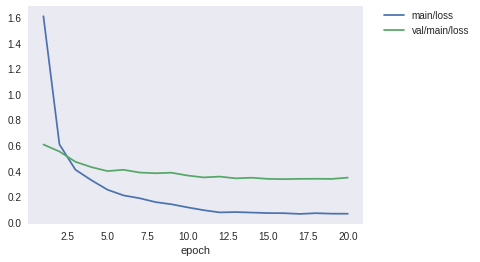
[19]:
Image(filename='AnimeFace-result/accuracy.png')
[19]:
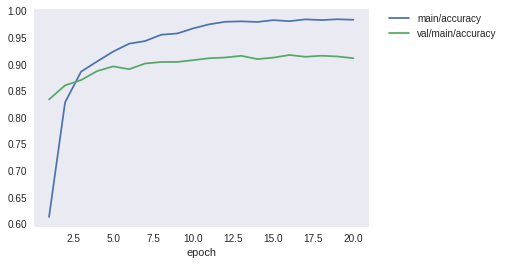
It seems that it has successfully converged.
Finally, we take several images from validation datasets, and look at the individual classification results.
[20]:
%matplotlib inline
import matplotlib.pyplot as plt
from PIL import Image
from chainer import cuda
chainer.config.train = False
for _ in range(10):
x, t = valid[np.random.randint(len(valid))]
x = cuda.to_gpu(x)
y = F.softmax(model.predictor(x[None, ...]))
pred = os.path.basename(dnames[int(y.data.argmax())])
label = os.path.basename(dnames[t])
print('pred:', pred, 'label:', label, pred == label)
x = cuda.to_cpu(x)
x += mean[:, None, None]
x = x / 256
x = np.clip(x, 0, 1)
plt.imshow(x.transpose(1, 2, 0))
plt.show()
pred: 191_shidou_hikaru label: 191_shidou_hikaru True
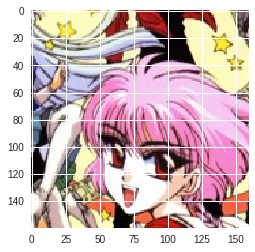
pred: 139_caro_ru_lushe label: 139_caro_ru_lushe True
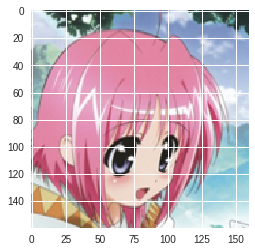
pred: 180_matsuoka_miu label: 180_matsuoka_miu True
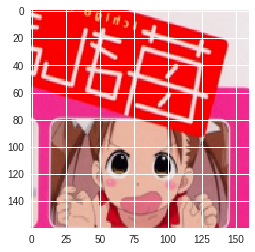
pred: 070_nijihara_ink label: 070_nijihara_ink True

pred: 001_kinomoto_sakura label: 001_kinomoto_sakura True
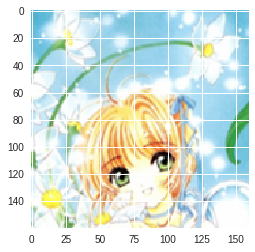
pred: 114_natsume_rin label: 114_natsume_rin True
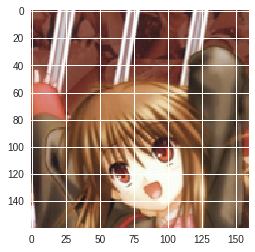
pred: 014_hiiragi_kagami label: 014_hiiragi_kagami True
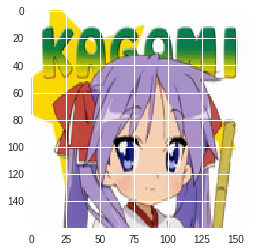
pred: 055_ibuki_fuuko label: 169_shihou_matsuri False
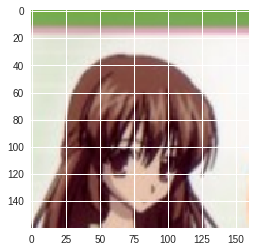
pred: 070_nijihara_ink label: 070_nijihara_ink True
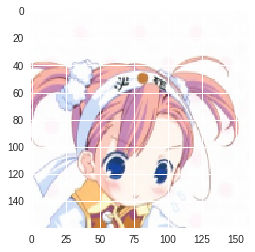
pred: 171_ikari_shinji label: 171_ikari_shinji True

When I randomly selected ten images, I got the 9 correct answers. How about you?
Finally, it may be usfull, we save the snapshot of the model.
[ ]:
from chainer import serializers
serializers.save_npz('animeface.model', model)
6. Extra 1: How to write dataset class in full scratch¶
To write a dataset class in full scratch, you have to prepare a self class that inherits the chainer.dataset.DatasetMixin class. That class must have __len__ andget_example methods. For example, it becomes as follows.
```python class MyDataset(chainer.dataset.DatasetMixin):
def __init__(self, image_paths, labels):
self.image_paths = image_paths
self.labels = labels
def __len__(self):
return len(self.image_paths)
def get_example(self, i):
img = Image.open(self.image_paths[i])
img = np.asarray(img, dtype=np.float32)
img = img.transpose(2, 0, 1)
label = self.labels[i]
return img, label
```
This class is instanciate with a list of image file paths and a list of labels arranged in a corresponding order. If we specify an index with the [] accessor, it load the image from the corresponding path, aligne it with the label, and return them as a tuple.
For example, it can be used as follows.
image_files = ['images/hoge_0_1.png', 'images/hoge_5_1.png', 'images/hoge_2_1.png', 'images/hoge_3_1.png', ...]
labels = [0, 5, 2, 3, ...]
dataset = MyDataset(image_files, labels)
img, label = dataset[2]
#=> it will return the image data and its label of 'images/hoge_2_1.png'.
This object can be passed directly to the Iterator and can be used for training using the Trainer. In other words,
train_iter = iterators.MultiprocessIterator(dataset, batchsize=128)
we can create an iterator like this, pass it to the updater along with the Optimizer.
7. Extra 2: How to make the simplest dataset object¶
Actually, the dataset for Trainer is ** just a Python list**. In other words, if **you can get the length with len() and the element can be retrieved with the [] accessor**, you can treat it as a dataset object. For example,
data_list = [(x1, t1), (x2, t2), ...]
If you make a list of tuples such as (data, label), you can pass them to the Iterator.
train_iter = iterators.MultiprocessIterator(data_list, batchsize=128)
However, the drawback of such a way is that you have to put the entire dataset in memory before training. In order to prevent this, the combination of ImageDataset and TupleDataset, and LabaledImageDataset are provided. Please refer to the document for details.
http://docs.chainer.org/en/stable/reference/datasets.html#general-datasets
[ ]: